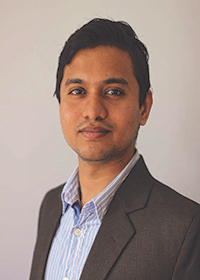“We want our tool to be as scalable and futuristic as possible. We want it to be able to function for any kind of pandemic.”
— Sai Dinakarrao, an assistant professor in the Department of Electrical and Computer Engineering

Sai Dinakarrao, an assistant professor in the Department of Electrical and Computer Engineering, is developing a software tool that factors in differences between parts of the country to pinpoint lifestyle strategies that would prevent surges in the coronavirus without taking a huge toll on the economy.
People hunkered down at home while many businesses, churches, and schools closed this spring to curtail the spread of the COVID-19, but one Mason Engineering researcher says that drastic lockdown strategy may not fit all areas of the United States.
Sai Dinakarrao, an assistant professor in the Department of Electrical and Computer Engineering (ECE), is working with other researchers to develop a software tool that factors in differences between parts of the country.
Looking at such factors as population density, demographics, climate, and transportation statistics could help determine strategies that would prevent surges in the virus without taking a huge toll on the economy.
“We want to tailor solutions for a given city, county, and state, despite having a small amount of prior data,” says Dinakarrao, director of the Hardware Architecture and Artificial Intelligence (HArt) Lab. “Our goal is to devise a better alternative to a full lockdown because we don’t want to hurt the economy.”
He and researchers from the University of California, Davis, and Morgan State University in Baltimore received a National Science Foundation RAPID grant for their project, “Collaborative Research: Developing Pandemics and Healing Models for Coronavirus COVID-19 to Assist in Policy Making.”
Their tool could determine if people in one area might need to lock down while those in another area could wear masks and practice social distancing to limit the spread of the disease, Dinakarrao says.
The tool will provide alternative scenarios to closing all shops and businesses. “This would let the economy at least keep walking, if not running,” he says.
Policymakers can use it to determine the best strategies for different parts of the country, Dinakarrao says.
Drawing from current COVID-19 data, the tool will incorporate machine learning and stochastic optimization techniques to determine the best epidemic confinement strategy, depending on demographic information as well as the epidemic spread.
“Given the uncertainty in the available data regarding COVID-19 due to varied testing strategies and false positives, our methodologies consider these variations to determine the optimal confinement strategy under the constraints of economic impact,” Dinakarrao says. The tool will be useful beyond the current pandemic, for other sorts of pandemics or epidemics by plugging in the right epidemic model.
“Eventually, we will develop a tool that is generic and demography-agnostic that determines the best solution for a given topology, such as a state, county, or city,” he says.
ECE Associate Chair Pelin Kurtay says, “While our medical and health care professionals are working diligently to fight this pandemic on the medical front, researchers like Sai have been hard at work to come up with innovative strategies to combat its economic toll.
“Sai and his colleagues are embarking on an interesting journey to help minimize the continued economic impact of this pandemic by developing a customized approach to lockdowns and social measures, and we are excited to see the results of this work. It has the potential to provide a much-needed bridge for our society,” she says.
The researchers just started the year-long project. The tool may be used for later waves of COVID-19, future pandemics, or to mitigate bioterrorism threats, Dinakarrao says.
“We want our tool to be as scalable and futuristic as possible,” he says. “We want it to be able to function for any kind of pandemic.”
“Sai and his colleagues are embarking on an interesting journey to help minimize the continued economic impact of this pandemic by developing a customized approach to lockdowns and social measures, and we are excited to see the results of this work. It has the potential to provide a much-needed bridge for our society."
— Pelin Kurtay, associate chair and associate professor in the Department of Electrical and Computer Engineering
